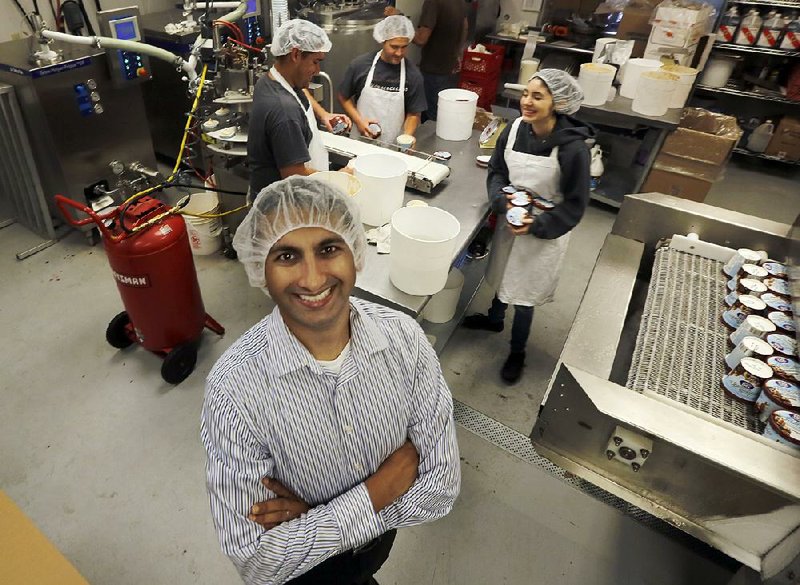NEW YORK - When a small business boasts about having big clients such as Wal-Mart or Procter & Gamble, their peers often want to know how they did it.
The truth is there’s no magic for such deals, just good old-fashioned pavement pounding.
The makers of Arctic Zero started small, selling their no-fat, ice cream-like frozen dessert to natural-food stores and independent grocers in Southern California.
But they wanted to get in national chains. It took a year and a lot of traveling to get into Whole Foods. It took four years to get on Wal-Mart’s shelves.
“It was just a lot of hustling, a lot of hard work, pitching, going in and talking,” Chief Executive Officer Amit Pandhi said.
While many small-business owners dream of selling to big companies, the competition is fierce.
Rivals can include entrenched national players or fast-growing upstarts. Corporate buying departments often aren’t interested in a product without a successful track record. To get in, small businesses have to persuade big companies to give them a chance.
To get its pints into Whole Foods, Arctic Zero visited many individual stores. Although big retail chains buy nationally or regionally, sometimes local store managers can buy some products on their own.
“We literally had to go store by store, region by region,” said Pandhi, whose company is based in San Diego. Finally, in about a year, Arctic Zero made it into a Whole Foods freezer case.
Pandhi’s pitch includes taking samples and showing off sales figures. Usually, it takes two to three conversations before a manager says yes.
After their first Whole Foods win, Pandhi and other Arctic Zero executives got the dessert into about 250 stores.
Whole Foods is looking for products that meet its standards for natural ingredients and that stand out from the pack in their food category, says Elly Truesdell, the company’s Northeast regional buyer. Companies also have to be willing to help promote their products - for example, with in-store demonstrations - so shoppers will know there’s a new product on the shelf.
While they courted Whole Foods, Arctic Zero also pitched Wal-Mart and grocery chain Kroger. In 2011, Kroger not only said yes, it decided to immediately stock all its 2,200 stores. Arctic Zero had to sign up more manufacturers to handle the demand.
After Arctic Zero’s success with Kroger, Wal-Mart followed, putting the frozen dessert in 2,300 stores and then expanding to 2,500, Pandhi says.
For Cedar Concepts, a Chicago-based business that makes small batches of chemicals used in consumer products such as shampoos and conditioners and for oil drilling and the manufacture of airplane parts, Linda Boasmond networked her way into contracts with Procter & Gamble, Colgate-Palmolive and Citgo for her company.
Boasmond attends about 100 events a year to meet with purchasing agents. She also belongs to industry groups like the Women’s Business Enterprise National Council and the American Cleaning Institute.
And even then it takes patience. It took three years for Cedar Concepts to get its own contract with Procter & Gamble. It landed that deal after first being a subcontractor to a company that had a direct contract with the consumer products company.
Sometimes, small producers turn to middlemen to win shelf space.
For example, supermarket beer aisles are dominated by megabrands like Budweiser and Miller. There are hundreds of craft beers vying for a place on the shelves, including Back Forty Beer Co., a Gadsden, Ala.-based brewer that got its start in local restaurants and bars.
To get into Wal-Mart and big supermarkets like Publix, Back Forty linked up with 18 wholesalers that have good relationships with large retailers. During a sales call, President Jason Wilson shows Back Forty’s sales figures. Later, the wholesaler follows up.
It took about two years from its founding for Back Forty to make it into some Publix and Wal-Mart stores in Alabama. In another year, it expanded into more stores around the South.
But once in, it’s not always smooth sailing. Sometimes stores carried Back Forty beer and then stopped ordering.Poor sales figures can lead to rejections. But Back Forty has weathered the challenges and is now in Target, Kroger and Winn-Dixie, another grocery chain.
“We’ve found ourselves in the unique position to open doors because of our wholesalers,” Wilson says.
Business, Pages 72 on 03/16/2014

